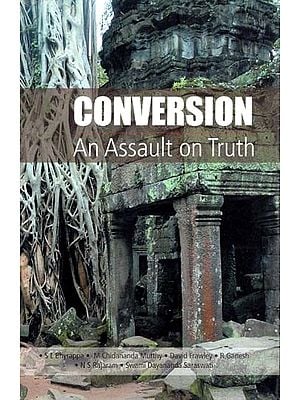Book Review - Conversion, An Assault on Truth
Book-1/2025
Title -
Conversion - An Assault on Truth
Authors - Dr
S.L Bhyrappa, M. Chidananda Murthy, David Frawley, R Ganesh, N.S Rajaram, Swami
Dayananda Saraswati.
Publishers -
Sahitya Prakashana, Hubli
First Published
Year – 2009
Image courtesy
– www.exoticindiaart.com
The book deals
with religious conversions in India, the Indian perspective and global
phenomenon, and the impact of religious conversions on Hindu demographics.
Before going
into a detailed review of the book, I want to express a little about my
perspective on religious conversions, which I will later elaborate on and make
into a book.
For me, there
are three perspectives for analysing religious conversions.
- Morality - To give a brief about the idea of
morality from a non-religious perspective, in general, morality refers to
the principles that define good or bad, right and wrong behaviour. If we
remove the class and religious perspectives of individuals, they are more
or less the same globally. If someone hurting you mentally or physically
is immoral for you, it applies the same when you hurt other people. (I
will elaborate on this viewpoint further in the book. For now, remember
this:
- Legality - Legality of an act or behaviour
comes into the picture when we are a part of an organised state. The
legality of a religious conversion depends on two aspects.
- What is happening in the absence of
a law governing religious conversions?
- What is included in the
anti-conversion act, if there is such legislation?
(Will discuss this based on the common
law and Indian law, in specific, in detail in the book)
3.
Religion/Culture – When we are speaking about
religious conversions, it will be inappropriate if we don’t observe and
understand the impact of those religious conversions on the local culture,
lifestyles, ecology, and economy.
(I will make an elaborate comment on this based on
Darwin's Evolution Theory, Social Identity Theory and Realistic Group Conflict
Theory in the book with examples).
I read the entire book keeping the above perspectives in my
mind. So, my review will have a lot of overlap with these perspectives.
Review:
To start with, the book is not for general reading. It has
a subtle intellectuality woven into every page that needs our attention. The
book was written in 2008 when India was under the mass influence of various
external forces resulting in mass conversions.
I am not mentioning the inclination of authors towards
Hinduism and polytheism as their names are well known in the ecosphere of
religious books and discourses.
The entire book is based on one basic tenet: Hinduism or
polytheistic religions are the Truth, and deliberate conversions by cash, kind
or force by Abrahamic religions are an assault on the culture of nations having
polytheistic religions. Though the book didn’t directly define why Hinduism or
polytheistic religions are considered to be true, there is a subtle message
echoed across the book about the spirituality associated with polytheistic
religions that allow individuals to seek higher realms of existence and peace
by culminating individual perspectives with the fundamental perspective on
which the religion was built.
The book went on to explain how the coercive and
fundamentalist behaviour of the Abrahamic religions aimed at the sole objective
of converting non-believers is flawed and cannot help humanity attain any
mental peace. The book is elaborative in explaining the indulgence of
Christianity and Islam in the denigration of non-believers and their
mistreatment over the centuries and across the nations.
The book also provides a critical perspective on the flaws
in Indian society and Hinduism from religious and legal standpoints.
This book also touched on the emergence of Christianity as
a religion and has many references to various religious books and discourses.
Finally, this book makes an interesting read if we are
interested in understanding how religions and beliefs are important in shaping
individuals, groups, nations, and humanity.


Comments
Post a Comment